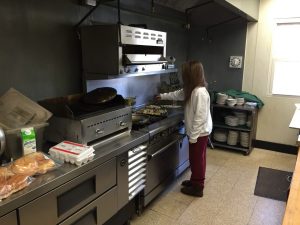Ramen noodles, according to the Cambridge Dictionary are “a Japanese meat or fish soup containing noodles and vegetables.” Although the definition conjures up images of the steamy noodle soup so commonly associated with Japanese culture, such a definition, according to Japanese tradition and practice, is much too simple. Ramen, as a whole, is separate from its generic noodle soup counter parts in that the dish is characterized by the use of kansui, alkalinized water reminiscent of mineral rich water once drawn from wells. This ingredient is vital to the iconic ramen noodles which are then added to broth, and topped with appropriate additions and garnishes, such as slices of fish cake, pork belly, eggs, green onions, and more. This use of kansui, lye, or general baking soda mixed with water, serves as the key ingredient that gives Ramen noodles their distinctive yellow color, earthy fragrance, and chewy texture. In essence, it is what keeps the noodles from boiling into mush despite bathing in steamy liquid; the noodles maintain their characteristic bounce while the broth remains warm and steamy. The ramen noodle concoction is simple: soup, noodles, and toppings. And yet, despite such simplicity in their very being, ramen noodles have become a sensation—a noodle soup superior to all other noodle soups. Diving deeper into the history of such a dish works to make this fact even more perplexing.
The negotiation that is possible with ramen is and has been vital to its development from a simple noodle soup. There are four commonly accepted classes of ramen soup, shio, shoyu, miso, and tonkotsu, three of which are dictated by the “flavor” and the final, tonkotsu, simply by its pork broth base. There is overlap within and between these three flavor classes across regions and according to place. Shio is the oldest form, first introduced to Japanese port cities by the Chinese upon the and miso is the newest. Shio style ramen is the original ramen soup, with origins dating back to the late nineteenth century in port cities with temperate climates that supported the success of light soup bases. Miso ramen started in northern Hokkaido in the mid 1960’s as a result of colder weather. The harsher temperature begged for a heartier soup with greater depth to satisfy the citizens. The intermediate flavor, shoyu, or Japanese soy sauce, is the ramen seasoning most popular in the Kanto region of central Japan. It originates from Yokohama, a port city near Tokyo that contributed to some of the early successes of ramen. The particular combinations of these flavors are what make for ramen’s variability along the vast scale of flavors, generally guided by shiro seasoned soups on the lighter end and miso seasoned soups on the heavier, with shoyu finding its place somewhere in between. As the lines separating the categories of ramen by flavor generally lead to overlaps and blending that make ramen variety unclear, regional diversity is instead differentiated according to heaviness. Two descriptions are generally used to describe the heaviness of the soup base: “kotteri” which is used to describe richer soup and “assari” which describes lighter bases. For thicker broths bones from pork or chicken are left to simmer for longer periods of time, whereas lighter broths usually call for fish or chicken bones simmered for less time. Regional variation is also marked by spice levels, which for the most part, are dictated by heavier or lighter use of chili oil within the broth. Broth variation is the most obvious and well recognized factor when it comes to ramen types, although all are distinctive qualities of the Japanese cuisine.
An interesting, yet frequently overlooked aspect of ramen is the variation of noodles included within the distinctive broths. By definition ramen noodles are made up of simple ingredients: wheat flour, salt, water, and konsui. Although the ingredients remain largely unchanged depending on the style of ramen, there are particular shapes of noodles associated with the soup bases. The noodles are engineered to best deliver the respective soup base to the mouth and taste buds of the consumer. The goal of varying the noodle type is to retain as much of the soup on the noodle throughout the “slurping” process. Although most ramen noodles, especially in western countries, are crinkly and extremely yellow in color, purposely reminiscent of the instant ramen to which Americans and Europeans are most accustomed, the noodle types vary by dish and soup base in traditional Japanese varieties. There are two common forms of ramen noodles: straight and wavy. Straighter noodles are more commonly used in thicker broths as the thick broth more effectively binds and is absorbed with the straight noodles as a vessel the fats cling to. The wavy noodles are meant to keep the thinner broths from quickly sliding down the noodles as the non-linear pattern slows their rapid descent. Although both act as vessels to bring their soup base with them, it is not ideal for them to simply soak up the broth. The perfect noodle is considered overdone after sitting in the broth for more than 5 min. This is why if ramen is taken to-go, the noodles are often separate, and this is only if the ramen place allows for to-go at all. This keeps the ramen at a level of quality the creator intends for the dish to be savored.
Two popular types of ramen are Tokyo style and Sapporo. Tokyo style ramen is categorized by its moderate thickness and slightly wavy noodles in an assari chicken and pork broth flavored with dashi and shoyu. Dashi is a broth made with bonito fish flakes and sea kelp and is used in a wide variety of different Japanese dishes. This Tokyo style shoyu ramen was one of the most popular forms of ramen until the recent boom of tonkotsu ramen. Sapporo ramen is known for its density. The noodles are very thick and the miso broth is thick to match. The broths are made from pork, chicken, or fish broths that fully use the miso’s functional thickness pairing. The particular type of miso often used is akamiso meaning “red soybean paste.” As Sapporo is a city in the north of the large island province of Hokkaido, and Hokkaido was the birthplace of miso ramen, Sapporo has become the center for ramen characterized by extremely thick ramen that fully utilized the new and in vogue miso flavoring.
Although it is unclear when exactly “ramen” was first invented, historians seem to agree that it is a result of Chinese relations. Origin stories of Japanese ramen noodles place its conception somewhere between the seventeen and twentieth centuries. The story that seems to describe the earliest possible immigration of ramen to Japan is described in a book published in 1987. The hypothesis is based on the historical record of a Chinese refugee advising Japanese feudal lord Tokugawa Mitsukuni to add a number of ramen-like ingredients to his udon soup as early as the 1660’s. However, it is unclear whether or not these noodles included the key ingredient in ramen noodles: kansui. As the chewy yellow noodles are the distinguishing factor between a noodle soup and true ramen, the styling of the udon in this story can only be suggestive of a new kind of style to noodle soup like ramen, but not the true origin. This legend however, is well favored by ramen enthusiasts, as it places the history of ramen much further back in history than the other origin stories. One that is more likely, however, places the conception of ramen in the time period that marked the opening of Japan. In the late nineteenth century, Chinese and Westerners, for the first time in over 200 years, were allowed entry into Japan. The Chinese brought their own noodle soups to the port cities in Japan such as Hakodate, Yokohama, and Kobe. These basic soups, devoid of toppings, likely became the initial, shiro-style adaptions introduced to Tokyo by pushcart peddlers in the early twentieth century. The soup-noodle street food, at this point in history, still had yet to undergo the preferential adaptations and changes that have formed the various dishes known as Japanese ramen today. Finally, the third hypothesis more or less adds specification to the second. It places the birth of ramen sometime between the late nineteenth and early twentieth century, yet it links ramen to a single creator. According to this tale, Ozaki Kenichi, who had once worked as a customs agent in Yokohama, opened a shop called Rai-Rai Ken that served the first ramen. The ramen that was served in his restaurant incorporated a characteristic soy-based seasoning sauce in the soup, chāshū (braised pork belly), naruto (fish-meal cake), green leafy vegetables, green onions, and nori, as well as an alkalinized noodle called Shina soba. In total, the dish attributed to Rai-Rai Ken and creator Ozaki Kenichi is seemingly the first instance of the iconic ramen noodle soup. From this dish, the ramen noodle was conceived, although many other changes throughout history had yet make their marks on the development of the dish.
In the early days of ramen, the dish was associated with early signs of industrialization and urbanization. The dish was seen as a foreign food, richer and heartier than the Japanese noodle dishes that did not contain meat broths or toppings. The dish typically sold from street carts and Western or Chinese-style restaurants, provided the nourishment and calories needed to fuel the developing country. Furthermore, as ramen noodles were one of the first industrialized foods, they were fast and inexpensive; a mechanical noodle-making machine could produce the key ingredient for ramen efficiently, therefore making the dish even more desirable. In the 1940’s, however, this wave of popularity was stopped in its tracks. World War II introduced Japan to food shortages and famines, as well as governmental regulations on foods supplies and food producers. Until 1949, no one in Japan was allowed to earn a profit via the sale of food—selling ramen could land on in jail. Moreover, ramen was associated with China and foreign influence, topics that became unfavorable in the midst of a world war.
After the war, with the Unites States occupying Japan, the country witnessed a shift in the food system. Food rations were still technically in place, as was the prohibition of outdoor sellers, yet ramen began making a comeback. In the time of this foreign occupation, wheat and lard imported from the United States became substitutes for the shortage of rice and meat experienced throughout the nation. This abundance of wheat made foods like bread and noodles the standard diet of the population. Wheat and lard, as well as garlic, became the main components of “stamina foods”, foods that filled bellies during the desperate times during and after the war. Ramen, almost by default, became the food that nourished the Japanese during an era characterized by great hunger and poverty. For this reason, ramen gained a reputation as a food made for desperate times, a food eaten only when the consumer could not afford anything else. It was only in the next generation, with the postwar economic boom in full swing, that ramen regained its shining status. In the period from 1955 to 1973, ramen, along with the rest of Japan experienced great nationalization. While the rest of the country began building venues and transportation projects for the 1964 Olympics, upscale restaurants specializing in the Japanese staple began to surface across the landscape. Ramen became a symbol with Japanese cuisine, but this time, in a luxurious and affluent light.
By the 1980’s, as ramen shops were still on the rise, it became clear the once peasant food had found a new clientele: the “Shinjinrui” or “new breed”. The new breed consisted of young urban consumers who flocked to the newly fashionable craft food. Ramen, unlike other traditional Japanese foods, was not bound by unspoken rules of preparation. The dish was open to innovation and experimentation by the new generations of young cooks, eager to provide their own interpretations of a Japanese staple. As a result, ramen and ramen shops became trendy, marked by limited menus and higher prices. Ramen’s ability to deviate from the set standards and norms made it all the more desirable among the younger generations. Ramen abandoned its status as a desperate source of fuel rooted in Chinese influence and American occupation, and instead became an icon, a symbol of Japanese cuisine. The once foreign import, and dish concocted from foreign ingredients had progressed to the focus of so many Japanese millennials’ obsessions. Eating ramen became a hobby distinguished by waits in hour-long lines at special shops and travels across the landscape to taste some of the regional varieties first-hand. By the 1990’s, some of the more renowned ramen chefs had even achieved a sort of celebrity status in Japanese culture. This rise to fame was fueled by the younger generation’s fascination with the noodle dish, which they took to the internet, and soon the rest of the world.
Although the art form of making ramen first started in Japan, it has since immigrated across the globe. Ramen has become a craze here, even in the United States with Japanese culture connoisseurs and hipsters alike. Some of the best ramen shops in larger Unites States cities such as San Francisco and New York call for one to arrive at five o’clock in the morning in the hopes of tasting the special dish at all that day. Specialty ramen has taken the country by storm, especially when considering the first instance of ramen likely occurred in Japan just over a century ago, nearly no time considering its roots can be dated back tens of thousands of years. Exactly how the craze made its way from Japan to countries like the United States in so little time is largely unclear. However, the over ten-year gap in the beginnings of the apparently similar trends, suggests the trend is not a result of translation from the younger Japanese generations to the new age of American. Although there is no one definitive reason as to why ramen noodle bars have become an American obsession, the trend is actually most likely a result of younger generations endearing relationships with a very special type of ramen noodles: instant ramen.
During the twentieth century, Japan provided the world with a number of life-changing inventions: the bullet train, the Walkman, the fuel-efficient car, digital cameras, emojis, karaoke, Nintendo, electric rice cookers, true ramen noodles, and greatest of all, instant ramen noodles. In a study conducted in Japan, in 2000, instant ramen was named the greatest invention of the twentieth century. Although the study only sought to discover the opinions of Japanese citizens, it is clear that ramen noodles have become a global sensation. Packages of ramen line the shelves of grocery stores across the world, lending themselves as a cheap, easy, and delicious food perfect for the working professional as well as the stressed broke college student.
The instant ramen was first welcomed to the world by Momofuku Ando in Japan in 1958, ten years after the end of World War II. After witnessing and experiencing food shortages in the midst of the post-war devastation, Ando sought to create a food that was tasty, nonperishable, quick, cheap, safe, and healthy. After many failed attempts to find an efficient means of preserving noodles that would rehydrate with a desirable texture, he found that tempura frying the noodles drove out the moisture while maintaining the bouncy texture of the noodles upon boiling. And so, instant ramen was born. “Chicken Ramen,” the world’s first instant noodle meal, was surprisingly enough, not created with the intention of becoming a junky filler food for starving college students. In fact, instant ramen cost more than fresh soup at a local ramen shop. Instead the instant ramen was marketed toward middle-class women and children as a complete easy and nutritious meal for nuclear families looking to avoid the flocks of students and working professionals who had taken over ramen shops. The product was a hit, so much so that other companies entered the Japanese market before instant noodles expanded their reach into Asia and the rest of the globe. The globalization of instant ramen into foreign markets has made this delicious food a staple beyond Japanese borders. Furthermore, the low cost and ease associated with ramen noodles have made them especially practical for and prevalent among college students. Ramen’s association with a younger age group has likely contributed to its popularity among hipsters and trend-setters in the United States.
Whenever my family goes on vacation, I spend my time shopping and sight-seeing while my brother chooses to spend his walking countless blocks to find hole-in-the-wall ramen shops top ranked ramen eateries. He gladly stands in line for hours and wakes at dawn just to try whatever ramen he is hunting for. I never questioned why—it was his hobby, his passion, the reason he has spent multiple summers in Japan tasting all that the country has to offer. He even took a class one summer, where he was taught the etiquette, values, and key concepts associated with ramen. Although he is far from your typical trend-follower, my brother has an insatiable love for ramen. When I questioned him about his obsession with the dish, he told me that it is the uniqueness of ramen that makes it worth waiting and searching hours for. It is filling and comforting without being boring. It’s the satisfaction of steak and potatoes, or chicken noodle soup, and yet it is impossible to get sick of. The variation makes it exciting yet in its essence, ramen is always smooth and comforting.
The ever-changing status of ramen makes it a particularly intriguing noodle dish. Its regional variations make the dish an icon of Japanese culture across the landscape. With nothing set in stone besides a need for warm broth and chewy noodles prepared for the heat by incorporating kunsui, ramen leaves much up to the artistic vision of the creator, as well as his or her culture and influence. From humble beginnings, and simple guidelines, ramen has endured over a century of changes in perception and acceptance, despite little change in character. The noodle dish is has remarkably not left a population untouched: from starving post-war survivors to new age Japanese students and professionals, from middle class Japanese families or American hipsters to college students on a budget. Ramen, whether it be viewed as a famine food or a trendy food, has never failed to satisfy the souls or the bellies of its consumers
Work Cited:
“ASIA-PACIFIC: Japan Votes Noodle the Tops.” BBC News, BBC, 12 Dec. 2000,
news.bbc.co.uk/2/hi/asia-pacific/1067506.stm.
Goulding, Matt. “Super Noodles: The Rise and Rise of Ramen.” The Guardian, Guardian News and Media, 22 Feb. 2016, www.theguardian.com/lifeandstyle/2016/feb/22/the-rise- and-rise-of-ramen-noodle-soup.
Herman, Alison. “The Messy History of Ramen.” First We Feast, 1 June 2018, firstwefeast.com/eat/2014/05/george-solt-on-the-messy-history-of-ramen.
“History.” History | World Instant Noodles Association, World Instant Noodles Association, instantnoodles.org/en/noodles/index.html.
“Japanese Inventions That Changed the Way We Live.” Cable News Network, CNN, 13 June 2017, www.cnn.com/2017/06/13/world/gallery/japanese-inventions-changed-how-we- live/index.html.
Leibowitz, Karen. “The Humble Origins of Instant Ramen: From Ending World Hunger to Space Noodles.” Gizmodo, 18 June 2013, gizmodo.com/the-humble-origins-of-instant-ramen- from-ending-world-5814099.
López, J. Kenji. “Guide to Ramen Varieties.” Serious Eats, 18 Apr. 2019, www.seriouseats.com/2013/09/the-serious-eats-guide-to-ramen-styles.html.
Lombardi, Linda. “The Social History of Ramen.” Tofugu, 11 Aug. 2014, www.tofugu.com/japan/history-of-ramen/.
“Ramen.” Cambridge Advanced Learner’s Dictionary & Thesaurus, Cambridge University Press, 2019, https://dictionary.cambridge.org/us/dictionary/english/ramen.






